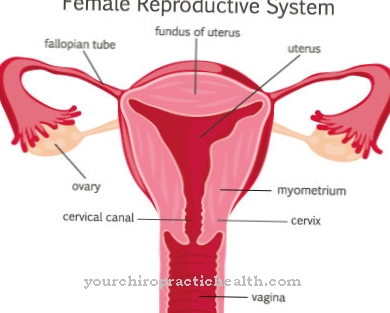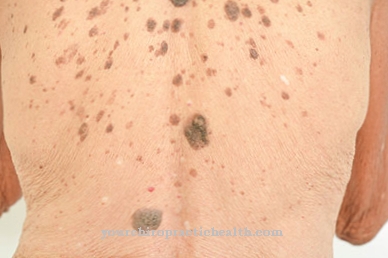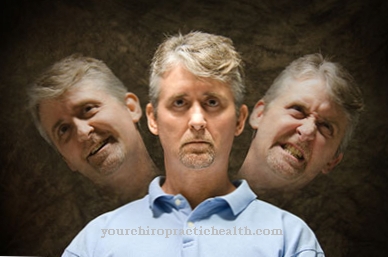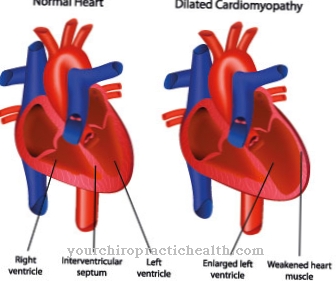As Patellar fracture is considered a fracture of the kneecap. This usually results in a rubble or transverse fracture.
What is a patellar fracture?

© matis75 - stock.adobe.com
At a Patellar fracture it is a fracture of the kneecap (patella). A typical feature of this injury is the appearance of debris or transverse fractures. Mixed fractions are also possible. In most cases, these are caused by falling on the knee.
The proportion of patellar fractures in the total number of bone fractures is around one percent. The human kneecap is part of the extensor apparatus. It prevents the thigh extensor tendons from rubbing directly on the knee joint. The patella moves on a thigh bone groove.
causes
Most kneecap fractures result from falls that occur on the flexed knee joint. The strong force causes the patella to break in two or more fragments. In a car accident, the kneecap, which is bent while sitting in the vehicle, can also hit an object such as the dashboard, which sometimes leads to its breakage. In such cases, medical professionals speak of a so-called dashboard violation.
In addition, there are certain sports that often result in a patellar fracture due to falls. This primarily includes inline skating and skateboarding. Occasionally, the abrupt bending of the maximally extended knee leads to a rupture of the patella. Sometimes a patellar dislocation (dislocation of the kneecap) is the cause of a kneecap fracture.
The human kneecap is just under the skin. For this reason, patellar fractures are often open fractures. This leads to the protrusion of bone parts through the skin.
Symptoms, ailments & signs
A fracture of the kneecap is noticeable by severe pain above the patella when moving and applying pressure. Because the pain is severe, the person usually cannot walk. Furthermore, no more stretching movements can be made in the knee joint. Another typical symptom of a patellar fracture is a bruise (hematoma). This appears as a swelling and a bruise. There is bleeding into the knee joint called a knee effusion.
Sometimes a crunch can be heard after the kneecap breaks. This sound is called crepitation in medicine and can be heard when the kneecap moves. It is not uncommon for the fracture of the patella to be accompanied by side effects such as cartilage injuries in the articular head region and damage to the bursa. If the fracture of the kneecap was caused by the transmission of force, fractures of the thigh shaft or a dislocation of the hip joint can occur.
Diagnosis & course of disease
In order to be able to make the diagnosis of a patellar fracture with certainty, the attending physician performs an X-ray examination. He takes pictures of the knee in two or three planes. In some cases, scintigraphy, computed tomography (CT), or magnetic resonance imaging (MRI) can also be performed. The differential diagnosis also plays an important role.
A rupture of the quadriceps tendon with a low kneecap or a patellar tendon tear with an elevated kneecap can also be responsible for the symptoms. The course of a kneecap fracture depends on its extent. The less the kneecap damage, the more favorable the long-term prognosis. In around a third of patients, even with optimal treatment of the fracture, exercise-dependent pain continues to occur. In addition, there is an increased risk of kneecap arthrosis and arthrofibrosis (joint scarring).
Complications
First and foremost, those affected suffer from very severe pain with a patellar fracture. The pain is sharp and can be so severe that the person concerned completely loses consciousness. Furthermore, the pain often spreads to other regions of the body and can lead to pain in the entire leg. The patient's quality of life is significantly restricted and reduced due to the patellar fracture.
Furthermore, there is usually severe swelling and a bruise on the knee joint. The movement of the affected person is significantly restricted by the patellar fracture, so that there may be restrictions in everyday life. Dislocation of the hip joint is also possible if the patellar fracture is not treated properly.
Persistent pain often has a negative effect on the psyche and can lead to depression and other mental disorders. Surgical intervention is usually necessary for a patellar fracture. However, there are no particular complications and the disease usually progresses positively. However, the affected person may still be restricted in their movement after the operation.
When should you go to the doctor?
If severe physical discomfort develops after a fall, accident or violence on the body of the person concerned, a doctor must be consulted. If there is a swelling of the knee or if the usual range of motion is restricted, a doctor is required. Pain, visual changes in the bone structure or circulatory disorders must be presented to a doctor immediately. Due to the numerous side effects and possible complications, pain reliever medication should not be used. Medicines to alleviate existing symptoms should only be taken after consulting a doctor.
If the knee joint can no longer be moved without symptoms, a doctor should be consulted. If a bruise develops on the knee, this is a characteristic sign of a patellar fracture. Since the disease, if left untreated, can lead to a significant deterioration in the state of health and further damage to cartilage, nerves, muscle fibers and tendons, the person concerned needs adequate medical care immediately. If there are noticeable changes in behavior, sudden severe tearfulness or intense inner restlessness, a visit to the doctor is recommended.
A doctor is required in the event of a racing heart, increased blood pressure, reddening of the skin and hypersensitivity to the touch. Feelings of numbness and sensitivity disorders should be presented to a doctor. If there is a disturbance of consciousness due to the pain, the emergency services should be alerted.
Therapy & Treatment
Treatment for a broken kneecap depends on the shape of the fracture. Both conservative and surgical therapy are possible. However, conservative treatment can only be undertaken if the fracture has not shifted. Such forms of fracture only exist if the reserve extensor device (retinaculum patellae) is still intact.
Longitudinal fractures, which in most cases only differ slightly, are also suitable for conservative therapy. If the periosteum is still intact, you can even dispense with immobilizing the injured knee. An early functional treatment takes place including pain-adapted full load.
In conservative therapy, the knee is immobilized with a sleeve made of plastic or plaster of paris. As a result, the fracture fragments cannot drift apart. For a certain period of time, the patient should not put any weight on the affected leg. With the help of repeated x-rays, the doctor can determine whether the treatment is successful. To avoid the formation of a thrombosis (blood clot), the patient is given injections of heparin.
If the bone fragments break apart after the kneecap has broken, surgical intervention must take place. The patient is given a spiral anesthetic or general anesthesia. As part of the operation, the surgeon removes the fibers of the extensor system from the fracture site and puts the individual fragments together. In addition, the joint surface is restored. An osteosynthesis is required to fix the kneecap fragments. This union of bones allows a functional follow-up treatment.
If there is an open fracture of the kneecap, the operation must be performed within six hours. Otherwise there is a risk of infection from colonized bacteria, which can spread to the entire knee. To prevent infection, the patient is given antibiotics.
Outlook & forecast
Most patients have a positive prognosis for a patellar fracture. The fracture of the kneecap heals in around 70 percent of all affected people within six to eight weeks. The respective leg can then be fully used again. Nevertheless, the patellar fracture is a serious injury that requires patience as it heals.
In addition, in the course of the break, some problems are possible that will negatively affect the prognosis. If there is a fragmentary or transverse fracture, cartilage irregularities may be present on the back of the kneecap even after surgery. Joint wear and tear, in turn, threatens the early onset of osteoarthritis, which can be seen in the plain bearing of the patella. But there are definitely ways to counteract osteoarthritis. The kneecap can be completely removed as part of a patellectomy.
Another conceivable consequence is the loss of strength in the thigh. In some cases, the knee is threatened with instability. It is not uncommon for the joint to not move as easily after a patellar fracture as it did before the injury. Sometimes the knee joint is stiff and painful after surgery. In most cases, however, these complaints subside after a while.
Orthopedic rehabilitation is recommended to improve the chances of recovery. It helps the patient to actively shape his normal everyday life again.
prevention
To avoid a patellar fracture, it is advisable to always wear protective clothing with knee pads when doing high-risk sports such as inline skating. When driving a car, rounding off the dashboard and lighting it up are sensible preventive measures.
Aftercare
In most cases of a patellar fracture, those affected have very few and sometimes very limited follow-up measures available. The person concerned should therefore contact a doctor at an early stage so that no further complications or complaints can arise. The patellar fracture usually cannot heal on its own either. Without expert treatment, the affected area can grow together incorrectly.
Most patients are dependent on an operation, which relieves the discomfort and alleviates the pain. After such an operation, the person concerned should definitely rest and take care of his body. You should refrain from exertion or from stressful and physical activities in order not to unnecessarily burden the body.
In many cases, obesity should also be reduced as much as possible. With the help of antibiotics, infections and inflammation can be prevented. The person affected should ensure that they are taken regularly and that the dosage is given. The consumption of alcohol together with antibiotics should be avoided if possible, as it weakens the effect of the medication. The patellar fracture usually does not reduce the patient's life expectancy.
You can do that yourself
A patellar fracture requires medical attention. The self-help measures are limited to protecting the injured kneecap and otherwise complying with the doctor's instructions. Since a kneecap fracture is associated with severe pain and restricted mobility, pain relievers must be taken. In consultation with the doctor, homeopathic remedies can be used to support the effects of the drugs or to taper them off at the end of the treatment.
Since those affected are sometimes bedridden as a result of the injury, their diet may also have to be changed. Regular massages and physiotherapy prevent pressure points and circulatory disorders. At the same time, the wound should be disinfected several times a day to prevent inflammation. If there is an open break, surgical measures are necessary. After the procedure, rest and bed rest again apply. In addition, the affected area must be carefully cared for as there is an increased risk of infection.
The patient must heal the injury for at least four to six weeks. Then you can slowly start exercising again. In less severe cases, recovery can be supported by physiotherapy measures or physiotherapy. Nevertheless, check-ups by the specialist are always necessary.






.jpg)


















.jpg)

.jpg)
